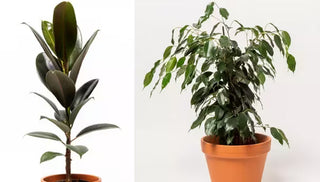Two popular types of Ficus: a rubber plant (L) and weeping fig (R)
You haven't dug into houseplants without stumbling across at least one Ficus on your journey! As members of the Moraceae family, Ficuses are native to tropical regions around the globe. While they have unique growth habits and foliage, they are collectively all known for posessing attractive leaves and intricate root structures. Extremely popular a houseplants, Ficuses are a bit particular about their growing conditions. Read on and learn more!
Types of Ficus
Known collectively as fig trees, Ficus is genus of around 850 different species. Not all are grown as houseplants, but here are some of the most popular species to try:
| Common Name | Botanical Name | Description |
|---|---|---|
| Rubber tree | Ficus elastica | Glossy, very broad, leaves grow upward on these plants |
| Fiddle Leaf fig | Ficus lyrata | Fiddle-shaped, flat leaves with slightly fuzzy undersides |
| Weeping fig | Ficus benjamina | Shiny leaves and a graceful, arching form |
| Ficus Audrey/Banyan tree | Ficus benghalensis | The national tree of India, it has smooth bark and oblong leaves |
| Ginseng ficus | Ficus microcarpa | A popular bonsai variety, this plant is known for its round, thick stems |
| Creeping fig | Ficus pumila | A woody-stemmed vining type with tiny heart-shaped leaves |
Best Growing Conditions For Ficus
Light
Ficuses generally prefer bright, filtered light. Direct sunlight can scorch their leaves, especially the variegated varieties. A spot near an east-facing window is ideal.
Soil
A well-draining, rich potting mix is essential for Ficuses — a mix of potting soil, peat, and perlite works well. They prefer a slightly acidic to neutral pH.
Humidity
If healthy and well-watered, your Ficus will tolerate standard household humidity just fine. As tropical plants, most Ficuses appreciate a humidity boost— consider misting your ficus plants or setting them near a humidifier if your home is particularly dry. They prefer consistently warm temperatures — keep them away from cold, drafty areas in rooms that remain at least 60 degrees F.
How To Care For Ficus Plants
Watering
Ficuses don’t like overly wet or completely dry soil — water when the top inch of soil feels dry. Ensure good drainage to prevent root rot.
Fertilizer
During the growing season (spring and summer), fertilize your Ficus every month with a balanced, water-soluble fertilizer. Reduce feeding in the fall and winter when growth slows.
Pruning
Prune to maintain shape and encourage fuller growth. This is especially important for varieties like the Ficus benjamina, which can become leggy. Use clean, sharp shears for pruning, and be sure to cut just above a leaf node to help encourage new growth. Prune in late winter or early spring, just before the plant awakens from dormancy and begins active growth again.
Repotting
Ficuses are fast-growing plants, and may require regular repotting to keep them looking healthy. Repot your Ficus every 2-3 years, or when it becomes root-bound. Spring is the best time for repotting. Choose a pot that’s slightly larger than the current one.
Propagation
Ficuses can be propagated through stem cuttings. Place a cutting in water or soil and ensure it has plenty of humidity and indirect light until it roots.
Common Problems with Ficuses
Pests and Diseases
Common pests include spider mites, mealybugs, and scale insects. Treat infestations promptly with insecticidal soap or neem oil. Overwatering can lead to root rot, so ensure proper drainage.
Toxicity
Ficuses are toxic to pets if ingested. Their sap can also be irritating to the skin and eyes — handle them with care, and consider wearing gloves when pruning or repotting.
Ficus FAQs
Q: Why are the leaves of my Ficus dropping?
A: Leaf drop in Ficuses can be a stress response to changes in the environment, such as changes in watering habits, or temperature fluctuations. These plants prefer consistency! Keep them away from drafty doors and windows, and keep their soil regularly watered.
Q: Can Ficuses be grown outdoors?
A: In warmer climates (USDA hardiness zones 9-11), Ficuses can be grown outdoors. They need protection from direct sunlight and prefer temperatures above 60°F (15°C) — try keeping them on a patio with some afternoon shade, and be sure to move them indoors if temperatures start to drop.
Q: How do I clean the leaves of my Ficus?
A: Wiping your Ficus leaves with a damp cloth is not just for appearance's sake — preventing dust from accumulating on the leaves helps increase the amount of available surface area for photosynthesis to occur. Wipe the leaves gently a clean cloth slightly dampened with water. No waxes or harsh cleaners are needed.
Bring the tree canopy indoors! With their large, glossy leaves, and attractive stems and roots, Ficuses are a superb addition to any houseplant collecion.




